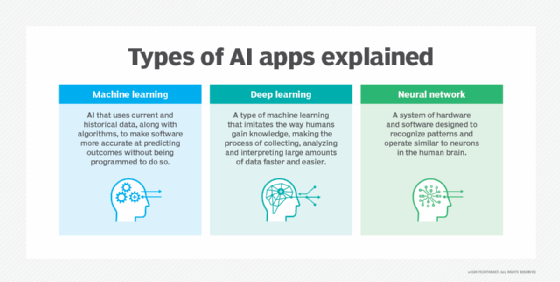Machine learning vs. neural networks: What's the difference?
Though machine learning and neural networks are both forms of AI, neural networks are a specific type of ML algorithm. Learn more about their similarities and differences.
Machine learning and neural networks are two common terms in AI -- but what do they mean, and how do they differ?
What exactly is machine learning?
Machine learning is a subset of AI. ML uses an algorithm, known as a model, to ingest and process data. That data is used to train, or teach, the ML model how to make decisions or reach conclusions.
Once trained, the model can ingest new data and make decisions or predictions based on that data. As a simple example, an online retailer might use ML to review a customer's purchases and preferences, then make future purchase recommendations to the customer based on their prior behaviors and choices.
ML models can be categorized as supervised, unsupervised or semisupervised, which refers to the degree of human intervention and feedback used to train the algorithm.
Generally, ML models require a significant amount of human effort to train. In the retailer example, training the ML model requires collecting, cleaning and analyzing data from customers with prior activity and recorded behaviors.
Other ML implementations might rely on a dedicated person to deliberately train the model to help the system identify patterns, perform tasks and reach accurate conclusions. ML typically depends on structured data available in known, well-standardized types or formats, such as a database.

Deep learning and neural networks: A subset of ML
Deep learning is a variant of ML that supports narrower but more detailed learning. Deep learning models make extensive use of automation, ingesting and using unstructured data -- such as text and images -- to build comprehensive decision-making abilities.
Neural networks, a type of ML algorithm, are typically the foundation of algorithms used in deep learning models. Sometimes referred to as artificial neural networks or simulated neural networks, neural networks are designed to mimic brain functions -- namely how neurons signal to one another.
Neural networks comprise layers of decision-making nodes: an input layer, numerous decision-making layers and an output layer. Each node is an artificial neuron, which makes a computation decision that has a weight and a threshold. When a node's inputs sum to a value above the threshold, the node sends data to one or more nodes in the network' s next layer; if not, no data is passed.
Types of neural networks include feedforward, recurrent, convolutional and modular. These terms refer to how data is passed from node to node across the neural network. The architecture of a neural network makes the computing process highly associative and extremely efficient, similar to a brain.
In effect, neural networks are collections of algorithms capable of identifying patterns. This makes them ideal for classifying and organizing data. As such, neural networks often form the backbone of complex tasks such as speech and image recognition.
Key differences between machine learning and neural networks
In short, the broad category of ML and the specific subcategory of neural networks can be differentiated as follows:
- ML algorithms ingest, parse and learn from data, then derive patterns or relationships from that training data. Neural networks use an array of ML algorithms organized in a way that mimics brain architecture.
- ML algorithms make decisions based on their training data, often with human guidance. Neural networks make accurate decisions with a high degree of autonomy and generally can learn from experience and previous errors.
- ML models can autonomously receive, learn from and make decisions based on data. Neural networks, which are built from many ML algorithms, are well suited to specific types of learning, such as recognizing an object in an image.
- Machine learning is often applied in areas such as retail, e-commerce, transportation, logistics and healthcare. Neural networks are typically used for forecasting, research, risk management, and speech and text recognition.
The two concepts are further distinguished by the underlying skill sets they require. ML professionals typically have a strong background in programming and algorithm development, statistical methodologies, big data analytics and infrastructure, as well as a comprehensive knowledge of ML frameworks. Experts in neural networks often additionally have an extensive skill set that encompasses data modeling, linear algebra and graph theory.








